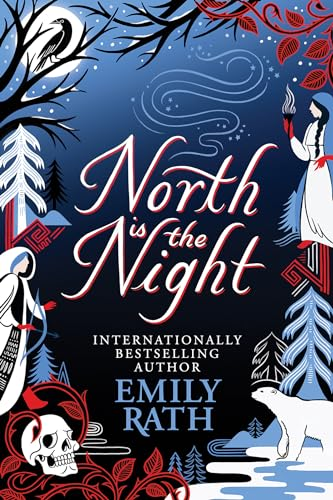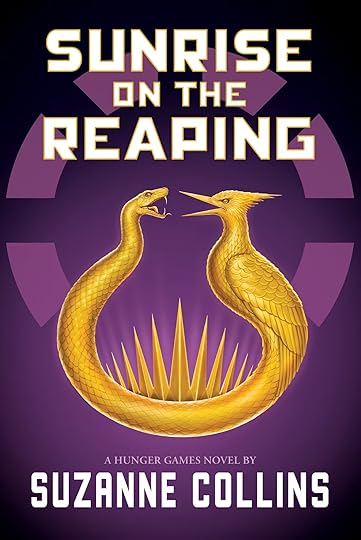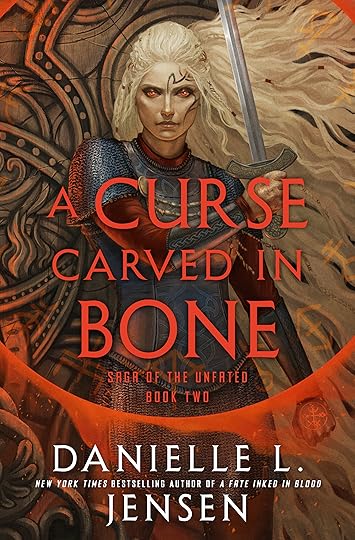Cailin Riley's Blog
October 13, 2025
On Baby Hiatus: Welcome, Baby Wycoff!
Baby Wycoff has arrived! My husband and I are so very excited to start this new chapter of our lives as parents.
I am taking a 3-month hiatus from the blog to focus on baby, family and the holidays. I will be back in January with new content and posts so keep an eye out around then!
Wishing you a magical autumn and enchanting holiday season,
Cailin
September 22, 2025
What I’ve Read So Far in 2025
I thought it’d be fun to take a moment and share what I’ve read so far this year! My reading in 2025 has been a bit of a mix — some five-star favorites, a few solid reads, and a couple that just didn’t quite stick. Still, I’m proud of how much I’ve managed to read in the midst of everything else life has going on.
Here’s a quick look at the books I’ve finished this year, along with my honest ratings:
The Let Them Theory by Mel Robbins – ★★★☆☆Our Crooked Hearts by Melissa Albert – ★★★★☆The Boneless Mercies by April Genevieve Tucholke – ★★★★☆Atmosphere – ★★★★★The House of My Mother: A Daughter’s Quest for Freedom – ★★★★☆Second Life: Having a Child in the Digital Age – ★★★★☆Before the Coffee Gets Cold by Toshikazu Kawaguchi – ★★★★☆The Perfect Couple by Elin Hilderbrand – ★★★☆☆The Fifth Trimester by Lauren Smith Brody – ★★★★☆The Tenant by Katrine Engberg – ★★★☆☆The Serpent and the Wolf – ★★★☆☆Margo’s Got Money Troubles – ★★★★★The Good Mother Myth – ★★★★☆Something in the Walls – ★★★★☆A Curse Carved in Bone – ★★★☆☆The Coddling of the American Mind by Greg Lukianoff & Jonathan Haidt – ★★★★☆Beach Wedding – ★★★☆☆Onyx Storm – ★★★★☆Godkiller by Hannah Kaner – ★★★★★A Few Quick Thoughts:Top Picks: Atmosphere, Margo’s Got Money Troubles, and Godkiller were all 5-star reads for me. Highly recommend!Strong & Steady: Books like The Boneless Mercies, Our Crooked Hearts, and Before the Coffee Gets Cold really delivered solid, immersive experiences.Meh Moments: A few titles landed at 3 stars — not bad, just not especially memorable for me personally.It’s been a good reading year so far, and I’m excited to see what the later half of 2025 brings. I’d love to know what you’ve been reading lately too — drop your recommendations in the comments or send me a message!
Until next time, happy reading! 
Cailin
September 8, 2025
Balancing a Writing Career with Real Life
Pursuing a writing career is a dream for many, but juggling that dream with the demands of everyday life — jobs, families, errands, relationships, and rest — can feel overwhelming. Whether you’re a full-time parent, working a 9-to-5, or managing multiple responsibilities, carving out time to write often feels like a puzzle with no extra pieces.
The good news? You don’t need to write eight hours a day to be a real writer. You just need consistency, flexibility, and a realistic view of what you can actually commit to.
Writing Isn’t All or NothingOne of the biggest myths about writing is that it has to consume your entire day or it’s not worth doing. The truth? Many successful authors build their careers by writing in small, regular chunks of time. You don’t need to write 3,000 words a day. Even 200 words a day adds up to a full novel in a year.
Set yourself up for success by asking: What’s realistic for me in this season of life?
Know Your Life SeasonSome seasons are busier than others. If you’re in the middle of moving, planning a wedding, raising young kids, or working overtime, now might not be the time to shoot for daily 2-hour writing sessions. That doesn’t make you less committed — it makes you human.
I’ve felt this firsthand. Since I started self-publishing in 2022, I’ve published three books — but life has been moving fast: I got married, bought a house, and now have a baby on the way. That meant writing and marketing took a backseat for a while, and that’s okay. Creative careers are flexible for a reason.
Find Your Writing WindowYou don’t need endless hours — you need a consistent routine that fits your lifestyle. That could mean:
30 minutes before workWriting during your lunch breakOne focused hour on Saturday mornings10 minutes of journaling before bedFind a window that works for you and protect it like you would a meeting or workout. Even a small, regular habit builds momentum.
Set Manageable GoalsInstead of aiming to “finish a novel,” try setting micro-goals like “write 200 words today” or “brainstorm chapter ideas this week.” Small goals build confidence and make the process feel achievable, even in the middle of a hectic schedule.
Balancing a writing career with real life doesn’t mean choosing one over the other — it means making space for both in a way that works for you. Writing is a long game, not a sprint. You don’t have to write full-time to be a writer. You just have to keep showing up, even in small ways.
Because the truth is: even 15 focused minutes a day is enough to keep your writing dream alive.
August 18, 2025
How to Start Brainstorming Ideas for Your Next Book (Even If You’re Stuck)
Every great book starts with a spark — but sometimes, that spark can feel maddeningly out of reach. Whether you’re a new writer or a seasoned author between projects, coming up with fresh, exciting ideas can be one of the most frustrating parts of the creative process.
The good news? Story ideas are everywhere. Seriously. You just have to train yourself to notice them — even (or especially) in unexpected places.
Here are some creative and unusual ways to jumpstart your brainstorming and find your next great book idea:
1. Write Down Your DreamsDreams can be weird, surreal, and fragmented — which makes them a goldmine for story inspiration. Keep a notebook or a note app by your bed and jot down whatever you remember as soon as you wake up. Maybe that creepy abandoned amusement park you visited in your sleep becomes the setting for a thriller. Or that bizarre interaction with a talking dog becomes the beginning of a magical middle-grade novel. Don’t question it. Just write it down.
2. Mine Your MemoriesSometimes, the best ideas are rooted in real life. Think back to your childhood, your awkward teenage years, your biggest heartbreak, or your proudest moment. What emotions stand out? What if you fictionalized that experience and turned it into something bigger? The truth — even when exaggerated — is often stranger than fiction.
3. Eavesdrop (But like, don’t be weird about it.)Next time you’re in a coffee shop, grocery store, or airport, listen to the snippets of conversation around you. A single line — “And then she just vanished with the ring” — could spark an entire mystery novel. People say the most interesting things when they don’t know you’re listening (just don’t be creepy about it).
4. Use Writing Prompts — Then Flip ThemWriting prompts are a classic tool for a reason, but try adding your own twist. Take a basic prompt and subvert the expected. For example, if the prompt is “a character finds a mysterious key,” ask yourself: What if the key unlocks something useless? What if it unlocks a person instead of a door? What if it doesn’t unlock anything, but everyone believes it does?
Final ThoughtsThere’s no single “right” way to come up with a story idea. The key is to stay curious, stay open, and let yourself explore without pressure. Don’t wait for inspiration to hit you like lightning — go out and chase it, even if it means wandering through your own dreams or laughing at an old inside joke. Your next book idea might already be waiting.
August 4, 2025
How Much Can a Self-Published Author Expect to Make in Their First Year?
Self-publishing has opened the door for many aspiring authors to share their work with the world without relying on traditional gatekeepers. But while the creative freedom is a huge win, many new authors wonder: How much money can I actually make in my first year of self-publishing? The honest answer? It varies widely — but for most, it’s modest at best.
The Reality of First-Year RoyaltiesFor most first-time self-published authors, earnings in the first year are relatively low. We’re talking anywhere from a few dollars to a few hundred. There are exceptions, of course — breakout authors who strike gold with the right book at the right time — but they’re not the norm. Without an established platform or an aggressive marketing strategy, sales tend to trickle in slowly.
When I started my self-publishing journey in September 2022, I had high hopes. Since then, I’ve published three books. But as of now, three years later, I’ve made less than $200 in royalties. That’s not to say the books weren’t a worthwhile project — I’m proud of what I’ve created. But it does highlight how critical consistent marketing is to building sales momentum.
Life Happens — and So Does the Pause on PromotionIn my case, life threw some wonderful distractions my way: marriage, buying a house, and now a baby on the way. All of these are amazing milestones, but they also meant I didn’t have the time or energy to fully promote my newer books. And that lack of marketing really showed in the earnings.
Self-publishing isn’t just about writing the book — it’s about constantly getting it in front of the right readers. That can mean running ads, building an email list, being active on social media, doing giveaways, and networking with other authors. When that effort drops off, so do the sales.
The Expense FactorIt’s also important to talk about costs. Even on a shoestring budget, self-publishing isn’t free. If you want a professional-looking product, you’ll likely need to invest in:
Cover design ($50–$500+)Editing and proofreading ($200–$1000+ depending on length)Formatting ($50–$200 unless you do it yourself)Marketing and ads (very variable, but many authors spend $100–$500+ per launch)These upfront expenses often mean that authors operate at a loss in their first year, especially if book sales are slow. It’s not uncommon to spend more than you make early on.
The Long GameThe good news is that self-publishing is a marathon, not a sprint. Books don’t vanish from shelves — they can continue earning income for years. Many successful authors don’t hit their stride until their fifth, seventh, or even tenth book. If you keep writing and publishing while gradually improving your craft and learning marketing strategies, earnings can grow steadily over time.
Final ThoughtsYour first year as a self-published author likely won’t be a financial windfall. But it is an important learning experience and the beginning of what can become a sustainable income stream — with persistence. My own earnings so far reflect the time and energy I’ve (or haven’t) been able to invest. And if there’s one lesson that rings true for all authors: marketing frequently and consistently really is key.
July 21, 2025
How to Get Started Creating Your Own Author or Book Blog Using WordPress
If you’re an author or book lover looking to build a community, share your writing journey, or review your favorite reads, starting a blog is one of the best moves you can make. I know it has been for me! And when it comes to blogging platforms, WordPress is hands down one of the most popular and flexible options available — trusted by millions of creators worldwide.
Here’s a simple, step-by-step guide to help you launch your own author or book blog using WordPress, even if you have zero technical experience.
1. Decide What Your Blog Is AboutBefore jumping into the technical stuff, get clear on your blog’s focus. Are you writing about your own books and author life? Reviewing and recommending books? Sharing writing tips and inspiration? Defining your niche helps you create content that resonates with readers and attracts the right audience.
2. Choose Between WordPress.com and WordPress.orgWordPress comes in two flavors:
WordPress.com: A hosted service that’s easier to start with but comes with some limitations on customization and monetization unless you pay for upgrades.WordPress.org: The self-hosted version that gives you full control over your blog but requires you to get your own web hosting and domain name.If you want maximum flexibility and professional growth potential, WordPress.org is usually the better choice for authors.
3. Get a Domain Name and HostingYour domain name is your blog’s web address (like yourname.com), and hosting is the service that stores your blog files online. Many hosting companies offer easy “one-click” WordPress installations to get you started quickly.
Popular, affordable options include Bluehost, SiteGround, and DreamHost. They often include a free domain for the first year when you sign up.
4. Install WordPress and Pick a ThemeOnce your hosting is set up, install WordPress (many hosts have this option in their dashboard). Next, choose a theme — this controls how your blog looks. WordPress has thousands of free and paid themes designed specifically for bloggers and authors.
Look for themes that are mobile-friendly, visually appealing, and easy to customize.
5. Customize Your BlogAfter choosing a theme, personalize it:
Upload your author photo and logo (if you have one).Create essential pages like About, Contact, and Books.Add a blog page where your posts will live.Customize colors, fonts, and layouts using the WordPress Customizer or your theme’s options panel.6. Start Creating ContentNow the fun part — writing! Focus on engaging, authentic posts that your audience will love. Share your writing journey, book reviews, author tips, or behind-the-scenes glimpses of your creative process.
Remember to post consistently and promote your blog on social media and email newsletters to grow your readership.
Final ThoughtsStarting a blog might seem intimidating at first, but WordPress makes it surprisingly accessible — even for beginners. By taking it one step at a time, you’ll soon have a professional, engaging platform to connect with readers and grow your author brand.
July 7, 2025
10 Practical Marketing Tips for Self-Published Authors (From a Full-Time Marketing Specialist)
Let’s face it: writing the book is only half the battle. If you’re a self-published author, you’re also the marketing team — whether you like it or not. The good news? You don’t need a marketing degree to get results. As a full-time marketing specialist by day and an author by night, here are 10 bite-sized, no-fluff tips that actually work — and won’t eat up your writing time.
1. Treat Your Book Like a Product
Don’t just promote “your book.” Promote the benefit it gives readers. Is it an escape, a solution, a thrill? Lead with that. Readers buy outcomes, not just stories.
2. Build Your Email List or Website Early
Email is still king. Start building a list before your book is out. Use a freebie (short story, sample chapter, bonus content) to hook subscribers. An easy way to hack this is to create a visually stunning author website and then use plug-ins to share your posts with subscribers.
3. Own Your Author Brand
Pick a consistent tone, color palette, and bio photo — and stick with them. You are your brand. Consistency builds trust and makes you look more professional instantly.
4. Use Social Media with Purpose
You don’t need to be everywhere. Pick one or two platforms where your readers hang out and show up regularly. Share behind-the-scenes, writing progress, and personal stories. Be human, not a sales robot.
5. Nail Your Book Cover and Blurb
This is marketing 101. If your cover screams “homemade” or your blurb is vague, you’ll lose readers before page one. Invest in a pro cover and workshop your blurb with other authors or readers.
6. Get Reviews the Right Way
Early reviews = credibility. Build a launch team of beta readers or reviewers. Give them an ARC (Advance Reader Copy) and ask (nicely!) for honest Amazon or Goodreads reviews. Just don’t pay for fake ones — readers can sniff that out.
7. Optimize Your Book’s Product Page
Before spending a cent on ads, make sure your Amazon (or other retailer) product page is doing its job. That means:
Your product page is your digital storefront — if it doesn’t convert browsers into buyers, no amount of traffic will help.
8. Collaborate with Other Authors
Cross-promote with authors in your genre. Bundle newsletters, swap mentions, or run group giveaways. Their readers are likely to become your readers too.
9. Repurpose Content Like a Pro
Turn one blog post into an Instagram reel, a newsletter tip, and a Twitter thread. You don’t need to reinvent the wheel — just remix what you’ve got.
10. Keep Showing Up
Marketing is a long game. Most books don’t go viral — they sell steadily over time. Keep learning, keep engaging, and keep writing.
You don’t need to be a marketing expert to succeed — just intentional and consistent. As someone who lives and breathes marketing for a living, trust me: small, smart actions beat big, flashy launches every time.
Now go sell that book — you’ve got this.
June 23, 2025
Tell Me: What’s the Best Baby Book You’ve Ever Read?
Usually on this blog, I’m sharing my own thoughts, but this time, I want to hear yours!
I’m currently expecting my first kid (due later this fall), and I’m starting to get into all the pregnancy and baby advice books. So far, I’ve found some to be helpful and others to be a little too out-of-date for me.
So, I would love to see if any of my blog readers out there have any recommendations!
I’m open to reading anything. My husband and I are not religious, but I’m not opposed to reading parenting books by faith-based authors. I’m also open to reading advice on parenting styles from a wide variety of cultures and belief systems.
If you have a good rec, please share them in the comments below! (Maybe the recs will end up in a future blog post about parenting books; who knows?)
June 10, 2025
Are Smut Books Ever Problematic? When Tropes Cross the Line
Recently, I picked up a new release in the fantasy romance genre—what’s often labeled as a “smut book.” It had all the makings of something I’d normally devour: a high-stakes world where dragon shifters battle for supremacy, and a juicy romance between a powerful shifter descended from Roman emperors and a fiery witch. But what started as an intriguing premise quickly made me uncomfortable. The heroine, the supposed central love interest, was captured and taken as a body slave by the dragon shifter—her eventual romantic partner.
I stopped reading.
I couldn’t shake the discomfort of the power imbalance. No matter how “steamy” the chemistry was written to be, I kept circling back to one question: what kind of meaningful consent can exist in a relationship that begins with slavery?
It got me thinking—are some smut tropes actually problematic, or is it just a matter of personal taste?
There’s no denying that smut, erotica, and steamy romance novels often play with extremes. Power dynamics, taboo themes, and dark fantasies are all over the genre. And for many readers, that’s exactly the appeal. Fiction is a space where we can explore desires, fears, and fantasies without consequence. Not everything has to mirror healthy real-life relationships. But when certain tropes—like sexual slavery or serial killer lovers—are romanticized without any critical distance or narrative unpacking, it raises some questions.
In the case of the dragon shifter book, the heroine is essentially coerced into a relationship. Even if the story attempts to frame their dynamic as consensual, the foundation is built on ownership and imbalance. That’s not inherently problematic—many dark romances operate within that space—but how it’s handled matters. If the book never acknowledges the disturbing elements or fails to give the heroine real agency, it stops being a fantasy exploration and edges into endorsing abuse.
So where’s the line?
For some readers, it is a “different strokes for different folks” scenario. We all have boundaries, and what feels problematic to one reader might feel like pure escapism to another. But intent and execution are crucial. There’s a difference between a story that uses dark tropes to challenge, question, or subvert harmful dynamics—and one that uses them for titillation without critical thought.
Writers can and should explore taboo themes if they choose. But they also need to be aware of the context and power of what they’re portraying. Readers can enjoy problematic content and still critique it. What matters is transparency: content warnings, acknowledgment of sensitive themes, and an awareness of the implications.
As readers, we get to decide what feels “icky,” unsafe, or just plain not for us. But it’s also okay to ask for better from the genre. Smut can be hot and responsible. It can be wild without being exploitative.
So yes, some smut tropes can be problematic—but the real question is whether we’re reading (and writing) them with awareness.
May 27, 2025
Best Books I’ve Read This Year – So Far
It’s only the end of May, but this year is flying by!
I don’t discuss my personal life very much on this blog, but I would like to share that I am currently expecting and due in October! This will be my husband and I’s first baby, so we’re deep in the process of baby registries and learning all we can about raising a tiny human.
I’m not sure how much time I will be able to dedicate to this blog once baby comes, but I am hoping to continue posting new content at least 2x a month. So please stay tuned!
All that said, I have really enjoyed some of the new books coming out this year. I think more authors are exploring new genres and plot lines, and the quality shows.
Here are a few of my favorite reads this year so far:
North is the Night by Emily Rath
I’ve always been a sucker for fairy tales and retellings, but this book is an entirely original story based off of a bevvy of Finnish folklore. I won’t say the prose in this book is fantastic but you won’t care because the characters and world-building more than make up for it. It feels like the book version of hearing your mom tell you a dark fairy tale for the first time as a kid.
Sunrise on the Reaping by Suzanne Collins
This might come as no surprise but I was quite The Hunger Games fan when the books first started coming out. I even remember getting my copy of the first book at an actual Scholastic book fair! Sunrise on the Reaping took me back to Panem but also fleshed out Haymitch in a way that was emotionally intriguing. This book proves that just because you know how a story ends, doesn’t mean that learning about the journey isn’t worth it.
A Curse Carved in Bone by Danielle L. Jensen (2nd book in duology)
If you like Norse mythology, Vikings and strong female protagonists, this series is for you. The first book in the series, A Fate Inked in Blood, helps set the stage but this second book really turns up the dial with great fight scenes, character development and relationship-building. It’s rare that I feel like an author gets actually better throughout a series, but it’s certainly true here for Jensen.



